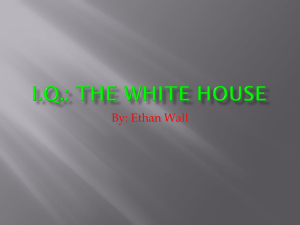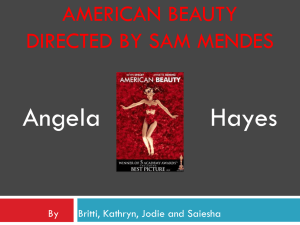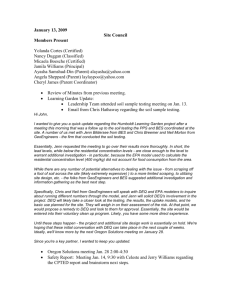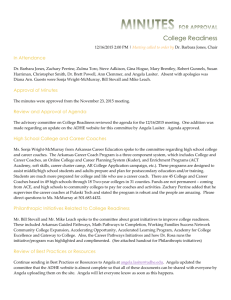JS Lect 5: Rhetorical Analysis: Writing Science
advertisement
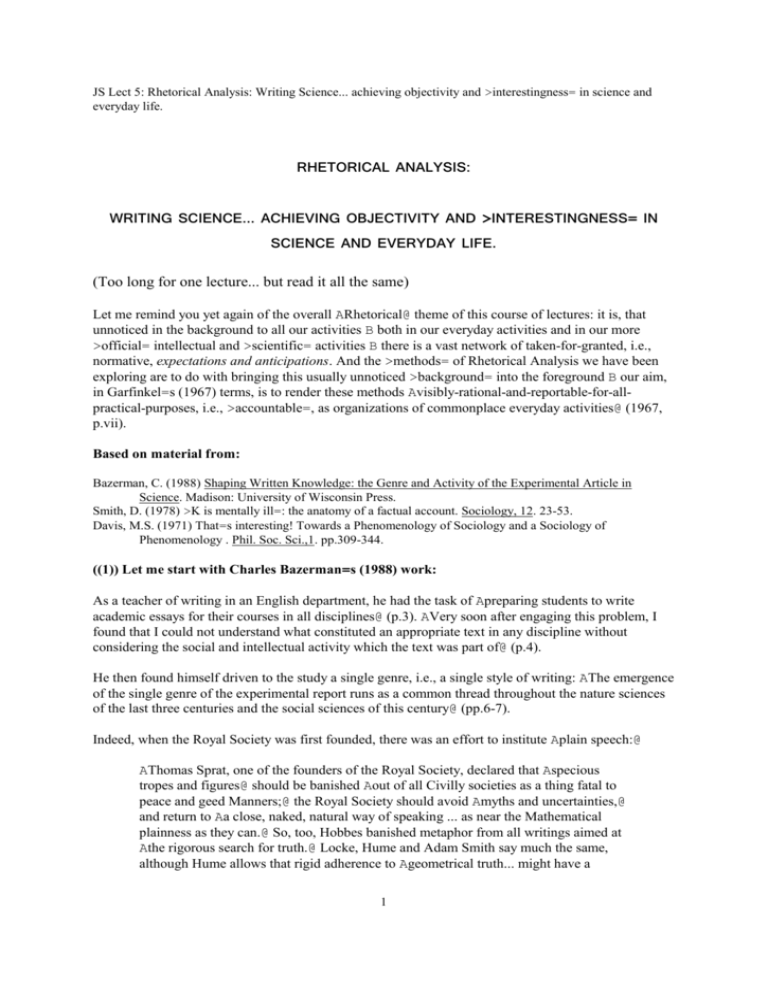
JS Lect 5: Rhetorical Analysis: Writing Science... achieving objectivity and >interestingness= in science and everyday life. RHETORICAL ANALYSIS: WRITING SCIENCE... ACHIEVING OBJECTIVITY AND >INTERESTINGNESS= IN SCIENCE AND EVERYDAY LIFE. (Too long for one lecture... but read it all the same) Let me remind you yet again of the overall ARhetorical@ theme of this course of lectures: it is, that unnoticed in the background to all our activities B both in our everyday activities and in our more >official= intellectual and >scientific= activities B there is a vast network of taken-for-granted, i.e., normative, expectations and anticipations. And the >methods= of Rhetorical Analysis we have been exploring are to do with bringing this usually unnoticed >background= into the foreground B our aim, in Garfinkel=s (1967) terms, is to render these methods Avisibly-rational-and-reportable-for-allpractical-purposes, i.e., >accountable=, as organizations of commonplace everyday activities@ (1967, p.vii). Based on material from: Bazerman, C. (1988) Shaping Written Knowledge: the Genre and Activity of the Experimental Article in Science. Madison: University of Wisconsin Press. Smith, D. (1978) >K is mentally ill=: the anatomy of a factual account. Sociology, 12. 23-53. Davis, M.S. (1971) That=s interesting! Towards a Phenomenology of Sociology and a Sociology of Phenomenology . Phil. Soc. Sci.,1. pp.309-344. ((1)) Let me start with Charles Bazerman=s (1988) work: As a teacher of writing in an English department, he had the task of Apreparing students to write academic essays for their courses in all disciplines@ (p.3). AVery soon after engaging this problem, I found that I could not understand what constituted an appropriate text in any discipline without considering the social and intellectual activity which the text was part of@ (p.4). He then found himself driven to the study a single genre, i.e., a single style of writing: AThe emergence of the single genre of the experimental report runs as a common thread throughout the nature sciences of the last three centuries and the social sciences of this century@ (pp.6-7). Indeed, when the Royal Society was first founded, there was an effort to institute Aplain speech:@ AThomas Sprat, one of the founders of the Royal Society, declared that Aspecious tropes and figures@ should be banished Aout of all Civilly societies as a thing fatal to peace and geed Manners;@ the Royal Society should avoid Amyths and uncertainties,@ and return to Aa close, naked, natural way of speaking ... as near the Mathematical plainness as they can.@ So, too, Hobbes banished metaphor from all writings aimed at Athe rigorous search for truth.@ Locke, Hume and Adam Smith say much the same, although Hume allows that rigid adherence to Ageometrical truth... might have a 1 disagreeable effect upon the reader@ (Berlin, 1976, p.104). AOne peculiar aspect of the accomplishment of scientific discourse is that it appears to hide itself. We know that poetry, laws, and newspapers are the active products of word-hagglers. The only ploy to minimize human linguistic agency in these endeavors is to invoke divinity, muses, or the depths of the human psyche. Yet to write science is commonly thought not to write at all, just simply to record the natural facts. Even widely published scientists, responsible for the production of many texts over many years, often do not see themselves as accomplished writers, nor do they recognize any self-conscious control of their texts. The popular belief of this past century that scientific language is simply a transparent transmitter of natural facts is, of course, wrong; the evidence presented in this book only confirms this conclusion argued so forcefully and frequently in recent years. It is nonetheless fascinating that such a misconception could have thrived so well in the face of the massive linguistic work that has gone into scientific communication@ (Bazerman, 1988, p.14). Why is it wrong? How is the illusions achieved? How can scientists themselves remain so unaware of their own rhetorical skills? Bazerman begins to uncover the rhetorical strategies at work by first outlining three criticisms of the idea that writing matters, Athat different choices of what to put on the page result in different meanings@ (p.19). Criticism 1 - Claim that the significance in written formulations lies Asomewhere outside of the symbols used to clothe them in the text@ (p.19). Answer 1 - However, as we have already seen B in say the Debbie and Nick, and Donnie and Marcia transcripts B people >struggle= with words at certain Asocial defined moments,@ often making several attempts, to make their words more fully do what they wish them to do. Criticism 2 - The second criticism inverts the first. It claims that Athe meaning of the text is enclosed entirely within a text, is purely the construct of arbitrary signs brought together in a text@ (p.20). Answer 2 - Our use of language, choice of words, style of writing, is always Aspontaneously responsive@ to events occurring in the context of our usage of it. In other words, it always Apoints beyond itself,@ toward the surroundings of its use. Criticism 3 - A third criticism is an extension of the second. The claim that Athe significant and creative action occurs in the living moment of spoken language instead of on the dead written page@ (p.21). Answer 3 - In reading a written text, we Arespond@ to the written words by drawing on the same set of Ataken-for-granted background expectations and anticipations@ as we draw on in understanding spoken language. Watson, J.D., and Crick, F.H.C. (1953) Molecular structure of nucleic acids. Nature, vol. 171, pp.737738 (a short paper of only 14 paragraphs). The first few sentences are below: A Structure for Deoxyribose Nucleic Acid AWe wish to suggest a structure for the salt of deoxyribose nucleic acid (D.N.A.). This structure has novel features which are of considerable biological interest. A structure for nucleic acid has already been proposed by Pauling and Corey. They kindly made their manuscript available to us in advance of publication. Their 2 model consists of three intertwined chains, with the phosphates near the fibre axis, and the bases on the outside. In our opinion, this structure is unsatisfactory for two reasons: (1) We believe that the material which gives the X-ray diagrams is the salt, not the free acid. Without the acidic hydrogen atoms it is not clear what forces would hold the structure together, especially as the negatively charged phosphates near the axis will repel each other. (2) Some of the van der Walls distances appear to be too small. Another three chain structure has also been suggested by Fraser (in the press). In his model the phosphates are on the outside and the bases on the inside, linked together by hydrogen bonds. This structure as described is rather ill-defined, and for this reason we shall not comment on it.@ Aspects of Bazerman=s analysis: 1) Take the first sentence: AWe wish to suggest a structure for the salt of deoxyribose nucleic acid (D.N.A.).@ $ $ $ $ $ $ $ $ $ $ $ $ $ $ $ The task of identifying a structure assumes, first, that there is a distinct substance which can be isolated and inspected and which has qualities distinguishing it from other substances. Further, this substance B DNA B is assumed to pre-exist the historical, human act of isolating and identifying the substance. In other words, the accumulated knowledge of the field (represented by the literature) is incorporated into the language. The isolation of elements and the theory of chemical combination, as well as the idea that substances can be analyzed chemically, are all implicit in the name of the object. More than that, the name reveals the gradually emerging orientation of chemistry to describe most features and processes through structure B hence the importance of the word Astructure@ in the first sentence. A further assumption: that nature arranges itself in geometrical ways. But further in the first sentence: Awe wish to suggest a...,@ reveals much about the joint persona and contribution of the two authors. No first person in scientific papers? The authors do assert their presence through the word we. However, is immediately subordinated to the object under consideration, the structure of DNA. Moreover, the authors are only suggesting, and the suggestion has only >a= suggestion. Whether it turns out to be the structure depends on nature. Also, A...wish to suggest...@ is a form of words which implies humility before the facticity of the object. Mild speech is possible because the suggestion will gain all the force it needs from the observation of reality; nature will stand up for scientists. The locution wish to suggest, appropriate here, might sound pompous in a branch of knowledge which does not find such immediate confirmation in nature. 2) The second sentence: AThis structure has novel features which are of considerable biological interest.@ $ $ First, it places a Achemical@ claim in the context of biological knowledge B this added context identifies the great importance of the paper. Yet the specific implications of the discovery are not at first spelt out B for it is assumed that once the novel features of the structure are made known, any competent biologist would see a wide range of implications. 3 $ $ $ $ $ $ $ $ Although later in the article (in paragraph 12) the authors comment: AIt has not escaped our notice that the specific pairing we have postulated immediately suggests a copying mechanism for the genetic material.@ This brief comment invokes the knowledge of genetics and cellular mechanics and tells the biologist where to fit this structure into the open claims of the field. The single added piece of information will allow biology to move forward in directions determined by its own logic. Pragmatically, it would be presumptuous, tedious, and unnecessary for Watson and Crick to also provide a lecture on the subject B refer again to Debbie and Nick/ Donnie and Marcia, and the pragmatics of only giving others the information they need, and not insulting them by telling them things they already know. It is worth noting that although the subject of the paper is structural, the consequences and import are functional. It is from the objective shape of things (their Astructure@) that one can better understand how things happen. The object talked about is taken as given, independent of perception and knowing. All the human actions mentioned is only in the process of coming to know the object B that is, in constructing, criticizing, and manipulating claims. 3) Lets look now at how they >dispose of= the competition: $ Here, the role of specific knowledge about the object of study is crucial. $ The Pauling and Corey model B which consists of three intertwined chains, with the phosphates near the fibre axis, and the bases on the outside B is dismissed as impossible on two counts, both based on knowledge of features of such molecules well established in the literature. Binding forces and van der Waals distances. $ $ $ $ The Fraser model is dismissed on the grounds that it is Arather ill-defined.@ This means that it cannot be discussed in relation to the Acopying@ problem. In other words, it is not Aconsequential@ enough B not Ainteresting@ (later ref to Murray Davis). 4) The main rhetorical work is done by the Adouble helix@ diagram and in 5 paragraphs 4-8: $ $ $ $ $ $ The five paragraphs are descriptive, recreating physical presence through the symbolic systems of words and numbers. But the symbols are more than approximate metaphors, the names point to discrete objects, and the geometry is of nature itself. Scientific language, as a symbolic system with a commitment to reform itself in accordance with replicable observation of nature, thus becomes more than an arbitrary symbolic system. After this long description of the model, only brief mention is made in paragraphs 9 and 11 of the evidence in hand that confirms the model and the evidence still needed to provide a rigorous test. Acceptance of the model depends on the confirming evidence; therefore, the sketchiness of the discussion of evidence might seem surprising. But once the model is described, the existing evidence needs only be referred to because it is generally available and can be interpreted by any competent molecular biologist. 4 $ The other researchers must satisfy themselves that the model fits past evidence and new tests. $ In other words, it is up to nature to persuade the readers, not the authors. Q.E.D!!! In his book, Bazerman goes on to examine the rhetorical structure (>structure= as explanation again!!!) of writing in a number of different disciplines, noting: $ $ $ $ There is in a discipline, a taken-for-granted form that Aknowledge@ is assumed to take. Thus, getting the words right is more than a fine tuning of grace and clarity; it is defining the entire enterprise. And getting the words right depends not just on an individual=s choice. The words are shaped by the discipline. $ $ $ $ $ 1) In its communally developed linguistic resources and expectations; 2) in its stylized identification and structuring of realities to be discussed; 3) in its literature; 4) in its active procedures of reading, evaluating, and using texts; 5) in its structured interactions between writer and reader. $ The words arise out of the activity, procedures, and relationships within the community. This is a part of what you are learning to do in your projects and exams... to write and read like all the other professionals in your field write and read. ((2)) Let me turn next to Dorothy Smith=s (1978) work: This is a >landmark= paper. $ $ $ $ The paper analyses an interview describing how K came to be defined by her friends as mentally ill. The method of analysis assumes that the structure of the conceptual scheme >mental illness= B which the reader uses in recognizing >mental illness= B is the same as that used by the writer in >writing up=, i.e., >organizing=, the text. Hence, we can discover this conceptual scheme >in= the text. Smith=s account shows how the text provides >instructions= for how the text should be interpreted by its readers, i.e., how they should read it >as factual=. Before turning to the Arhetorical structures@ Smith finds in the text, let me just say how she set out our use of Aconcepts@ in this paper. For it is this, that I take to be one of the most useful parts of this paper. She points out that: ARecognizing in events the >fact= that someone is mentally ill involves a complex conceptual work. It involves assembling observations from actual moments and situations dispersed in time, organizing them, or finding that they can be organized, in accordance with the >instructions= which the concept provides@ (p.26). $ $ In other words, recognizing something as a something of a particular type, is not simply a matter of matching up a fixed shape with an already existing a picture. It is much more to do with a Away or style of looking@ C a matter of looking at something with a whole set of expectations and anticipations in mind. 5 $ $ $ Consider the Faces/Vase ambiguous figure B looking first with face-expectations (chin, then mouth, then nose, then eyes, etc), and then switching to vase-expectations (rim of bowl, bowl, stem, and then base). An account which is immediately convincing is one which enables a certain sequence of expectations to be fulfilled and which makes any others difficult. Then the events of the account will display an order giving them Athe shape of the fact@ for the reader/hearer. 1) Preliminary instructions: Like PWC=s notion of a Apreformulation,@ various initial things said by Angela in her interview (lines 15-20) orient the reader toward interpreting >what is to come= as an account of someone becoming mental ill. My recognition that there might be something wrong was very gradual, and I was actually the last of her close friends who was openly willing to admit that she was becoming mentally ill. (15-20) In other words, Angela is providing a set of instructions here about how the rest of the interview is to be read, and what it is an account of. Thus: That K is 'becoming mentally ill' is asserted as a fact at the outset and is preserved as such throughout. The same construction is offered at various other points in the text. As follows: they had to face the fact that K was definitely queer (78-79) we gradually began to realize that she just could not cope (93-94) I refused to acknowledge the fact that there was anything definitely wrong with K. (101-102) Such constructions establish that K's state is to be treated as something which $ $ (a) is a fact and (b) is therefore already there prior to, and independently of, its being >admitted', >realized', >faced', or >acknowledged' by Angela or others. 2) The construction of the account as factual: the Arhetoric of fact@: Let us first note: $ $ $ $ $ $ The actual events reported are not facts. It is the use of proper procedure for categorizing events which transforms them into facts. A fact is something that has to be categorized, to be worked up to conform to the model of what that fact should be like. To describe something as an Aobjective@ fact, or to treat something as a fact, implies that the events themselves B what happened B entitle or authorize the teller of the tale to treat certain events as unavoidable falling in the category of Afacts@ B >It=s not a matter of my opinion=, >Whether I wish it or not, it is a fact=. >Whether I will admit it or not, it is a fact=. Etc... Thus, the rhetoric of the fact is here that 1) Angela is constrained to recognize it. It is a fact independently of her wish; she does not wish it and yet she is >forced to face= it. And 2), that if something is to be constructed as a fact, then it must be directly seen as appearing in the same way to anyone, and not just based on hearsay from others. 6 Hence we get in the account a series of steps in which the circle of those recognizing that something is >wrong= with K is gradually increased: (a) at lines 21-32, Angela alone; (b) at lines 29-32, Angela and Trudi; (c) at lines 55-71, Angela, Trudi, and Angela=s mother; (d) at lines 113-127, Angela, Trudi, Angela=s mother, and Betty; (e) at lines 129-134, Angela, Trudi, Angela=s mother, Betty, and a woman friend of the family. The construction of a fact involves displaying that it is the same for everyone, and that their recognition of it as a fact is based on their own direct recognition of it B they have not been persuaded by others >getting at them=. But why should they all see it as Amental illness@ B and not, say, as simply a matter of K=s reaction to being Asocially excluded@? As Smith sees it, the collection of items in this account is not grandly convincing. The teller of the tale has to do a good deal of working up in order to display K=s behavior as being Amentally ill.@ There are even some that might be viewed as positive characteristics if the perspective were shifted just a little B e.g. K=s insisting >that she had to swim 30 lengths= (25-26) on a hot day at the pool is entirely appropriate for someone with a concern for fitness; or her working so devotedly in her friend=s garden might be a particularly creditable interpretation of the obligations of friendship. So, Smith suggests, we can begin looking at this collection with the hunch that the teller of the tale has to do rather a lot of contextual work to show how the behavior can read as being a matter of K being Amentally ill.@ How is this contextualizing work done? Through the medium of what Smith calls Acontrast structures@ (see CA notes). Here are some examples: When asked casually to help in a friend=s garden, she went at it for hours, never stopping, barely looking up (34-36) She would take baths religiously every night and pin up her hair, but she would leave the bath dirty (70-81) When something had gone radically wrong, obviously by her doing, she would blandly deny all knowledge, (87-88) What happens in a contrast structure, is that a description of K=s behaviour B she went it for hours B is preceded by a statement that provides >instructions= for how that description should be read B when asked casually B >instructions= that draw upon the normal expectations present in our shared background with Angela, Trudi, etc.... Other contrast structures working in the same way: (i) It was obvious that she was terrified of anyone getting too near to her, especially men. (ii) And yet she used to pretend to us (and obviously to herself too) that she had this and that really keen on her. (43-45) 7 (i) she would bath religiously every night and pin up her hair, (ii) but she would leave the bath dirty. (79-81) (i) When something had gone radically wrong, obviously by her doing, (ii) she would blandly deny all knowledge.... (87-88) To sum up what Dorothy Smith shows in this article, then, let me return to Garfinkel=s (1967) account of enthnomethodology. He says he wants to Aanalyze everyday activities as members methods for making those same activities visibly-rational-and-reportable-for-all-practical-purposes, i.e., >accountable=, as organizations of commonplace everyday activities@ (1967, p.vii). And this is what Dorothy Smith does here: she makes Angela=s methods B in accounting for K=s behaviour as indicative of Amental illness@ B visibly-rational and reportable. In short, she shows us what Angela=s methods are: Angela shows that K=s way of behaving is anomalous, i.e., deviant, and that others see it in the same way too. QED!! ((3)) Let me turn finally (and briefly) to Murray Davis=s article: AThat=s interesting!:@ What makes a theory great? $ $ $ a theorist is considered great, not because his/her theories are true, but because they are interesting the truth of a theory has very little to do with its impact the capacity to stimulate interest is a necessary characteristic of greatness What theories are considered interesting? $ $ $ the interesting is something which engages the attention the defining characteristic of a theory which an audience considers interesting is, that it an anomaly (Kuhn ,1962) B it contrasts with routinely taken-for-granted propositions which make up the structure of everyday life a new theory will be noticed only when it denies an old truth What theories are considered in the paper? $ $ $ only social, particularly sociological theories are analyzed only those theories which have been in Awide circulation@ have been considered the common element of all interesting propositions is that they always deny certain assumptions of their audience Some examples of ATHE INTERESTING@ (Davis provides an INDEX of 12 categories). I will mention just a few examples: He cites examples of: Organization; Composition; Abstraction; Generalization; Stabilization; Function; Evaluation; Co-relation; Co-existence; Co-variation; opposition; and Causation (i) ORGANIZATION $ What seems to be an organized (structured) phenomenon is in reality a disorganized 8 (unstructured) phenomenon. EXAMPLE: Karl Marx=s assertion in Capital that the economic processes of bourgeois society, which were considered at the time he wrote to be organized in one way, are in fact not organized in that way (but rather organized in another way). (ii) COMPOSITION $ What seem to be assorted heterogeneous phenomena are in reality composed of a single element. $ EXAMPLE: Sigmund Freud=s assertion throughout his Collected Works that the behaviour of children, primitives, neurotics, and adults in crowds, which were considered at the time he wrote to be unassociated in any way with one another, are in fact all various manifestations of the same instinctual drives. $ (iii) ABSTRACTION $ What seems to be an individual phenomenon is in reality a holistic phenomenon. $ EXAMPLE: Emile Durkeim=s assertion in Suicide that suicide, which was considered at the time he wrote to be a behaviour characteristic of an individual, is in fact a process characteristic of a society. (vii) EVALUATION $ What seems to be a bad phenomenon is in reality a good phenomenon. $ EXAMPLE: R. D. Laing=s assertion in The Politics of Experience that schizophrenia, which was considered at the time he wrote to be a bad thing, is in fact a good thing. (xii) CAUSATION $ What seems to be the independent phenomenon (variable) in a causal relation is in reality the dependent phenomenon (variable). $ EXAMPLE: Howard Becker=s assertion in Outsiders that the peculiar behaviour of some individuals, which was considered at the time he wrote to cause other people to label them >deviants=, is in fact caused by other people labelling them deviants. The criterion for Anon-interesting propositions:@ $ $ the defining characteristic of an interesting proposition can be used to determine the criterion of a non-interesting proposition the criterion of a non-interesting proposition: it does not deny some aspect of the assumptionground of its audience Three general types of non-interesting propositions: $ $ $ $ $ $ 1) Instead of denying some aspect of the assumption-ground of its audience, a proposition affirms some aspect of the assumption-ground of its audience. The audience=s response: AThat=s obvious!@ 2) Instead of denying or affirming some aspect of the assumption-ground of its audience, a proposition does not speak to any aspect of the assumption-ground of its audience at all. The audience=s response: AThat=s irrelevant!@ 3) Instead of denying some aspect of the assumption-ground of its audience, a proposition denies the whole assumption-ground of its audience. The audience=s response: AThat=s absurd!@ 9
